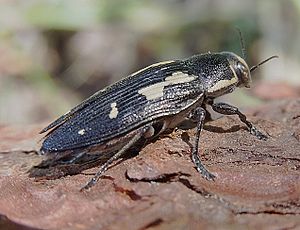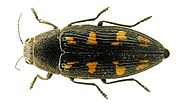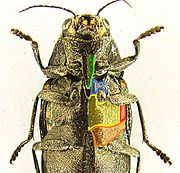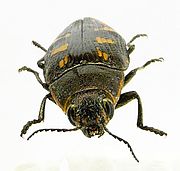Nine-spotted jewel beetle
| Nine-spotted jewel beetle | ||||||||||||
|---|---|---|---|---|---|---|---|---|---|---|---|---|

Nine-spotted jewel beetle ( Buprestis novemmaculata ) |
||||||||||||
| Systematics | ||||||||||||
|
||||||||||||
| Scientific name | ||||||||||||
| Buprestis novemmaculata | ||||||||||||
| ( Linnaeus , 1767) |
The Neunfleckige jewel beetle ( Buprestis novemmaculata ) is a beetle from the family of jewel beetles (Buprestidae). The twelve to twenty millimeter long animal is well camouflaged by the ore-colored coloration despite the yellow spots on the wing covers and is easily overlooked. In addition, it is not common in Central Europe. It is easily confused with the eight-spotted pine splendor beetle .
Like most jewel beetles, the species is specially protected by law in accordance with the Federal Species Protection Ordinance. In the Red List of Endangered Species in Germany, the species is listed under category 2 (endangered). In Saxony-Anhalt it is considered endangered (category 3) and in Brandenburg it is on the pre-warning list as potentially endangered .
Comments on the name and system
The species was first described by Linnaeus in 1767 as Buprestis 9-maculata . After the brief characterization and the statement that the beetle can be found in Bavaria, one reads in the more detailed description: ... Maculae luteae: 1 in medio frontis, 2 ad thoracis latera, 3 in singulis elytris ... .. ( lat. : yellow spots, one in the middle of the forehead, two on the side of the chest, three on each wing cover ...). This explains the species name novemmaculāta (Latin nóvem, nine and maculātus, spotted) even if the number of spots often deviates.
The genus Buprestis was established by Linnaeus when the binomial nomenclature was introduced . The name was adopted from Linnaeus and can be traced back to well before Linnaeus in entomological literature. However, it was used there in a different sense. Βούπρηστις Bōūprestis is the name of an insect (beetle?) In Hippocrates of Kos that cattle accidentally swallowed, causing them to swell - maybe Lytta vesicatoria or Meloe , at least not our Buprestis . Meaning of the word: (gr.) Bu- "ox-", prestis "ship" ?, "fish" ?, "lightning" ?, "saw" ?, "plant"? Schenkling explains Buprēstis from Old Gr . βούς, bōūs, beef, and πρήθω, prētho, “I bloat” as the name for a beetle among the Greeks, after which the cattle are supposed to swell up and die after consuming it.
As a rule, Linnaeus counts every jewel beetle in the genus Buprestis . Eschscholtz split the genre into many genres in 1829. According to him, only those species remain in the genus Buprestis in which, together with other anatomical features, the label is rounded at the back. Today fourteen species belong to the genus Buprestis in Europe, of which twelve belong to the same subgenus, two each to a different one. Worldwide there are over a hundred species in ten subgenera. The species Buprestis novemmaculata occurs in two subspecies, Buprestis novemmaculata novemmaculata and in Southeastern Europe as Buprestis novemmaculata gravida .
Description of the beetle
The body is robust and more than twice as long as it is wide. The top is flattened (picture 4, picture 5). The underside is also hairy brown and gray. Not only the wing covers have yellow spots, but also the head and pronotum, the sides and the underside (picture 3) can be spotted yellow. However, the staining can also be greatly reduced.
Seen from above, the head is much wider than it is long. The indentations into which the antennae are inserted (antennae sockets) are far apart, near the edge of the eye (Fig. 4). They are small, not deep and not cut off at the edges. The eleven-part feelers are widened inwards from the third link onwards (sawn, Fig. 4). The eyes are large and cover most of the sides of the head. They don't touch the base of the upper jaw. Its rear edge runs parallel to the front edge of the pronotum , but does not lie directly against it. The parting is not narrowed. The upper jaws are strong, slightly curved and two-toothed. The last two jaw buttons are elongated and of the same size. The lip switch end link is egg-shaped and truncated.
The pronotum is narrowed in front to the width of the head, broadest at the base. It is dotted , but often has a smooth median (Fig. 1 without median, taxo image with median).
The elytra are broader at the base together than the pronotum. They are evenly arched without impressions and more arched than Buprestis dalmatina . They are gradually pointed towards the middle, the edge is not serrated. They are trimmed at the top and have an inner and an outer tooth. The wing covers are striped. The stripes near the seam are not very densely dotted in the spaces between them, the dotting becomes dense towards the edge of the wing. The label is small and rounded at the back. Each wing cover has 4 irregular and frayed spots, which can also merge or be missing. As a rule, in contrast to the very similar eight-spotted pine splendor beetle, the lateral edge of the elytra behind the shoulder is not clearly expanded and is not colored yellow near the shoulder.
On the underside, the hip cavities of the front chest, into which the front hips are turned, are open to the rear. The spherical front hips are separated by a broad extension of the front chest to the rear (Prosternal process, picture 2 green). The protosternal process protrudes over the mid-breast (Fig. 2, blue) and appears to separate it. The rear hips (picture 2, orange) lie wide of the rear breast (picture 2, yellow) and are not expanded inward. They are hollowed out towards the rear to partially accommodate the hind legs. The strong legs all have five-limbed tarsi (tarsi formula 5-5-5). The claws are imperforate. The plate of the exoskeleton (posterior episternum, image 2, red) lying to the side of the rear chest is not covered by a lateral widening of the abdomen.
Occurrence
Lives in coniferous forests especially on pines . Is widespread in Europe and also in Asia .
Way of life
The beetles can be found on old trunks, stumps and branches, also on felled wood. The larvae live in freshly dead coniferous wood ( pine and spruce ), on which they feed. They pupate after two to four years.
swell
literature
- Fritz Brechtel, Hans Kostenbader (ed.): The splendor and stag beetles of Baden-Württemberg. Eugen Ulmer, Stuttgart 2002, ISBN 3-8001-3526-4 .
- Heinz Joy, Karl Wilhelm Harde, Gustav Adolf Lohse: The beetles of Central Europe . tape 6 : Diversicornia . Spectrum, Heidelberg 1979, ISBN 3-87263-027-X .
- Gustav Jäger (Ed.): CG Calwer 's Käferbuch. 3. Edition. K. Thienemanns, Stuttgart 1876.
- Klaus Koch : The Beetles of Central Europe Ecology . 1st edition. tape 2 . Goecke & Evers, Krefeld 1989, ISBN 3-87263-040-7 . P. 93.
Individual evidence
- ↑ Fritz Brechtel, Hans Kostenbader (ed.): The splendor and stag beetles of Baden-Württemberg , Eugen Ulmer Verlag Stuttgart 2002, ISBN 3-8001-3526-4
- ↑ Red lists at BioNetworkX
- ↑ C. Linnaeus: 1767: Systema naturæ, Tom. I. Pars II. Editio duodecima reformata First description page 132: 662
- ↑ Sigmund Schenkling: Nomenclator coleopterologus 2nd edition Jena 1922 Explanation of the scientific beetle names (species) in short form
- ↑ Sigmund Schenkling: Nomenclator coleopterologus 2nd edition Jena 1922 Explanation of the scientific beetle names (genus) in short form
- ↑ Johann-Friedrich Eschscholtz: Zoological Atlas…. 1st issue. Berlin 1829 Division of Buprestis p. 8
- ↑ Buprestis at Fauna Europaea. Retrieved March 25, 2013 Buprestis Buprestis (subgenus) from Fauna Europaea. Retrieved March 25, 2013 Buprestis Cypriacis (subgenus) from Fauna Europaea. Retrieved March 23, 2013 Buprestis pseudyamina (subgenus) from Fauna Europaea. Retrieved March 25, 2013
- ↑ Genus Buprestis at BioLib




